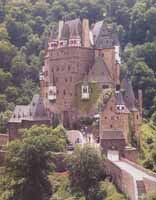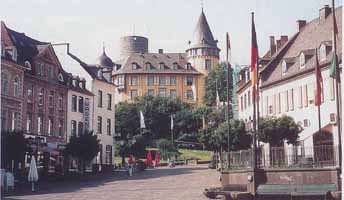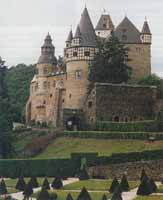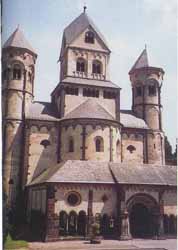
(Click on photo to enlarge)
by Dr. Gregory H. Wolf
History, wine, and unique geology combine to form a delightful travel destination between the Rhine and Moselle rivers
The Eifel, the romantic hill country framed by the Rhine River and Germany's western border and Aachen and the Moselle River, is characterized by its diverse and attractive landscape: dormant volcanoes, volcanic lakes, rolling hillsides, man-made reservoirs, and the romantic towns, castles, and monasteries located throughout. Historically, the Eifel was a poor region due to its harsh climate and the fact that it was divided into so many smaller states and principalities. Nonetheless, the area is steeped in German history. It was an important military and economic center during the Roman period when, in the fourth century, Emperor Constantine ruled the Western Empire from Trier, located in the southern part of the Eifel. Charle- magne, or Karl the Great, as the Germans prefer to call him, founded and ruled the Carolingian Empire from Aachen in the north, which was also the city in which the emperors of the Holy Roman Empire, from the tenth through sixteenth centuries, were crowned. The Eifel
has endured some of the most savage and destructive battles in German history.
During the Thirty Years' War (1618 to 1648) roaming bands of soldiers and mercenaries plundered the region. In the closing stages of World War II, the Eifel was ravaged by some of the fiercest fighting on German soil when the Germans attempted one last military offensive campaign.
Though American tourists flock to the Moselle River to enjoy the wines or visit Aachen and Trier to experience history, many American tourists neglect one area: the Eastern Eifel centering around the picturesque town of Mayen, approximately eighteen miles west of Koblenz and just a thirty-minute drive from the Moselle. An excursion to the Eastern Eifel will prove to be worthwhile, as tourists will encounter romantic towns and villages and a volcanic landscape unique in Europe.
Arriving in Mayen, a town of approximately twenty thousand residents and surrounded by rolling hills, one will be greeted by the impressive Genovevaburg, which rests atop a slight elevation. From the south side, the castle reveals its medieval history as a defensive fortress, complete with the one hundred-ten foot Gala Tower. This architecture contrasts with the Baroque-inspired deep-yellow color and smaller, more ornamental towers on the northern side of the castle. From atop the Gala Tower, one will see the medieval remnants of the city: city wall, city gates, and towers. From this point one can walk directly into the vibrant pedestrian zone with its bustling cafes and shops. Passing through the open market, two of the city's landmark buildings can be seen: the Old Town Hall from 1717, one of the best preserved eighteenth-century town halls in Germany, and the Gothic St. Clemens Church with its crooked steeple, which, as legend has it, was done by the devil. Mayen is also home to the critically acclaimed "Burgfestspiele," plays performed every summer in the courtyard of the Genovevaburg.

ABOVE:
In medieval times, Mayen's Genovevaburg served as a fortress for the city.
The Genovevaburg houses two excellent museums which introduce tourists to Mayen's and the Eifel's long history as a center for mining basalt lava and slate used for the construction of houses, bridges, and roofs evident throughout the Eifel and especially Mayen, often called the "City of Stones." The Eifel Museum contains exhibits on the geological and cultural history of the Eifel with an impressive array of tools and artifacts, and historically accurate reconstructions of living
and working quarters. The newly opened Schieferbergwerk Museum (slate mine museum) is unique in all of Europe. The visitor will travel by elevator approximately fifty feet underground into a former World War II tunnel bunker beneath the castle to encounter a re-creation of a slate mine. Wearing hard hats and cloaks, tourists can experience first-hand, through a number of interactive exhibitions, the seven-thousand-year history of mining in the Eifel and the dangers and difficulties it presents. The museums also contain an exhibition on the bombing of Mayen at the end of World War II. Roughly ninety percent of the city was destroyed or damaged and it was later declared a "Dead City."

ABOVE:
Bürresheim Castle was built over a period of five hundred years.
When in Mayen, one is minutes away from two spectacular castles. Highly recommended is a leisurely hike to the Bürresheim castle, located approximately two miles from Mayen, and a scenic, twenty-minute drive to the Eltz castle. Both Bürresheim and Eltz are located in romantic valleys named for the narrow streams running through them: the former in the picturesque Nette valley and the latter in the Eltz valley. These castles are among the few in the entire Rhineland that avoided destruction throughout the tumultuous epochs of foreign invasion and war. Built in stages from the twelfth through seventeenth centuries, Bürresheim contains one of the largest collections of original furniture and possessions of nobility. The medieval Eltz, a fairy-tale like castle, offers visitors the opportunity to tour a residence still in use today. From the castle, one can also hike to the Moselle River. On the drive to the Eltz castle from Mayen, one will pass through the historically and culturally important town of Munstermaifeld, centered around the collegiate church of St. Martin, characterized by its fortress-style facade.
Monreal, also located in the Eltz valley and just minutes by car from Mayen, is considered one of Germany's most beautiful towns. Though completely destroyed by the Swedish army during the Thirty Years' War and then by the French in the late seventeenth century, Monreal nonetheless offers a charming and seemingly undisturbed impression. With its majestic castle ruins, the Lowenburg and the Phillipsburg dating from the thirteenth century, Monreal transports its visitors back in time. Strolling through this city of just nine hundred residents, tourists are struck by large, impeccably restored half-timbered houses, which give testimony to Monreal's history and wealth as an important textile and weaving center in the sixteenth through eighteenth century. Half-timbered houses and the Gothic Parish Church from the thirteenth century line the meandering Eltz stream. Crossing the Eltz are several stone bridges, which provide tourists with stunning views of the artwork of the half-timbered houses and courtyards.
|
|
|
|
Castle ruins high above the streets of Monreal. |
Mayen's Old Town Hall dates to the eighteenth century and is one of Germany's best preserved. |
Because of its unique geological landscape and history, the Eifel has always attracted geologists interested in volcanoes and volcanic history. The Eastern Eifel is the home of several fascinating volcanic museums and parks. Of special interest is the Vulkanmuseurn (Volcanic Museum) in Mendig, located just twenty minutes from Mayen. This museum exhibits a thorough collection of volcanic stones and minerals from the region, but the main attractions are the underground basalt mines. Descending approximately one hundred feet underground, tourists can walk through the mines' great halls, some of which are almost twenty feet high. During the nineteenth and early twentieth centuries, the cavernous mines were used to lager beer. Even today one can enjoy a locally brewed beer from Mendig in the historical Vulkan Brauhaus. In the Vulkanpark in Plaidt, near Mendig, one can hike
through a diverse volcanic landscape.

Maria Laach Abbey
Just minutes from Mendig is the largest volcanic lake in the Eifel, the Laach Lake, commonly referred to as a "maar" because it was formed by a vol- canic eruption of gas and steam instead of molten lava. Not only can one hike around the lake or spend an afternoon swimming or renting a boat, one can visit the peaceful Benedictine monastery, Maria Laach,
situated on the lake. Founded in 1093 and completed in 1230, Maria Laach is one of the finest and best-preserved examples of Romanesque architecture along with the cathedrals of Speyer, Worms, and Mainz. The abbey is an imposing structure with two towers on both the east and west choir and a squared atrium garden through which one enters the church. Historically a cultural center of the Eifel, Maria Laach is the home to a vibrant, self-supported Benedictine community which offered Konrad Adenauer,
who later became the first Chancellor of the Federal Republic of Germany, refuge when the Nazis attempted to arrest him during World War II.
From the Eastern Eifel one can take short excursions to other regions in the Eifel, such as the Ahr Eifel to the north or the Vulkan Eifel to the west. The Ahr Eifel is considered the red wine paradise of Germany and is the tenth largest wine producing area in the country. Highly recommended is a stop
in one of the small, romantic wine villages along the Ahr River, such as Altenahr. Motor enthusiasts will want to see the Niirburgring, the legendary Formula One racetrack in Adenau. With its excellent opportunity to hike and bike, the thinly populated Vulkan Eifel is one of the main tourist attractions in the Eifel. In the Daun region, tourists can hike around the three Daun Maars, the Weinfelder Maar, the Gemiinder Maar, and the Schalkenmehrener Maar, or see one of the few geysers in the Eifel, the Brubbel in the town of Wallenborn.
For those planning a trip to the Eifel, several websites may serve as a productive starting point:
www.eifel.de is an easy-to-navigate site in German and English containing links to hotels, restaurants, tours, hiking/biking trails, as well as other information on all regions of the Eifel. For those who can read German,
www.eifeltour.de and
www.eifelvista.de are comprehensive sites which contain not only tourist information on various regions and cities in the Eifel, but also links on the history, geology, and economy of the Eifel.
Dr. Gregory H. Wolf, an Assistant Professor of German Studies at Saint Louis University, publishes on a number of topics on German history, literature, and culture, and last contributed to German Life in the October/November 2003 issue with an article on Bamberg. He has lived and worked for at least part of every summer since 1998 in Mayen.
Article originally published in GERMAN LIFE magazine, DEC E M B E R 2004/ J A N U A R Y
2005 issue, pp. 33-35.